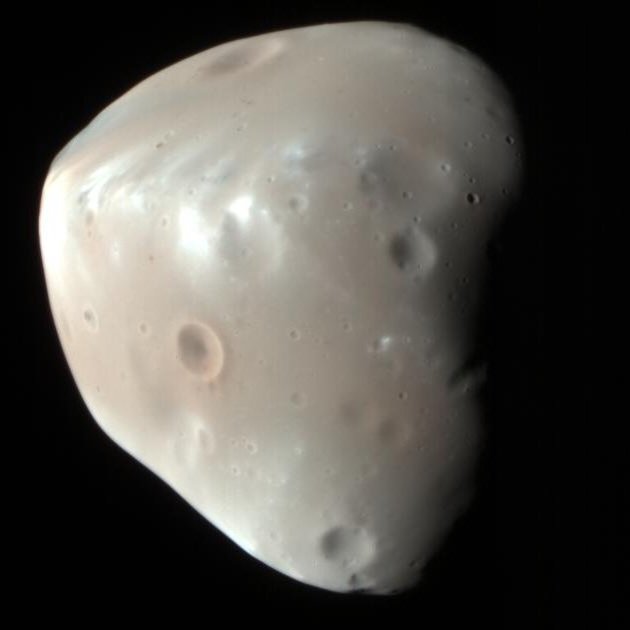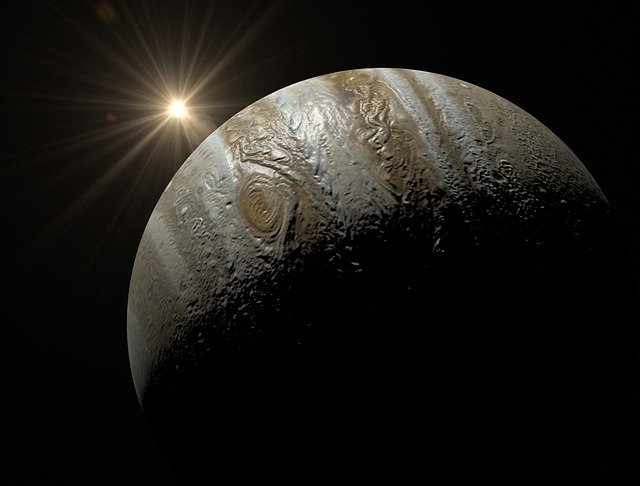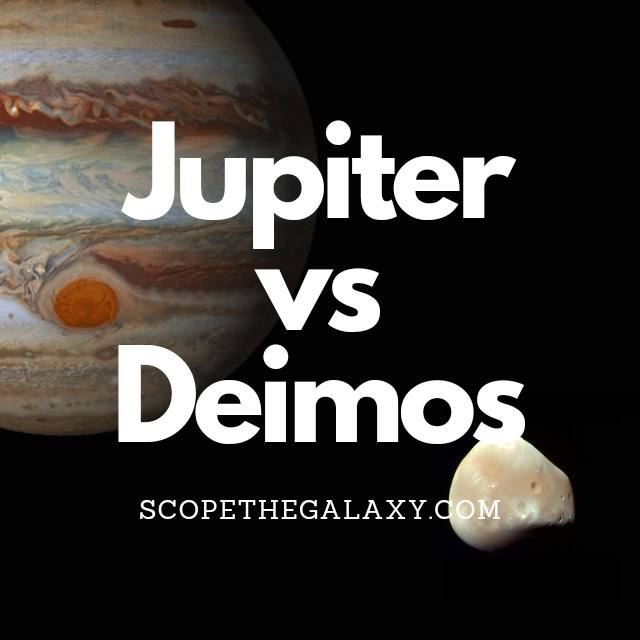*This post may contain affiliate links. This means we may make a commission if you purchase an item using one of our links*
The main differences between Deimos and Jupiter are that Deimos is a natural satellite and Jupiter is a gas giant planet. Deimos is very small with a diameter of 12.4km compared to Jupiter’s 139,820km, Jupiter has 79 objects orbiting it while Deimos has 0 and Jupiter has the strongest magnetosphere in our solar system while Deimos doesn’t have one.
For a more detailed look at both entities along with their similarities, continue reading as it will be covered in more detail throughout the remainder of this article.
What Is The Moon Deimos?
Table of Contents

Deimos is the smaller and outermost of the two moons of Mars, named after the Greek God of dread and terror (the brother of Phobos). This satellite was also discovered by American astronomer Asaph Hall just five days before Phobos (12th August 1877).
Scientists like Johannes Kepler had put forward theories for the existence of these moons many years before they were discovered. Their calculations were based on the fact that the planets on either side (Earth and Jupiter) possessed one and four moons, respectively.
Still, none were discovered until the 19th century. One of the main reasons for this is that the tiny size of Phobos and Deimos, combined with an exceptionally close orbit to their planet, means that the glare of Mars often obscures our view of them.
Phobos measures just 15 x 12 x 11 km and completes an orbit of Mars once every 30 hours.
This tiny moon is also a heavily cratered landscape shaped by the impact of asteroid collisions over time. However, the material thrown up from these impacts doesn’t appear to have landed back on the moon’s surface as it usually would. This could be because the lack of gravity on Phobos allowed the ejected material into space.
The surface gravity on Deimos is just 0.003 m/s^2 (compared to 9.807 m/s^2 on Earth), which means the average gravitational pull of Deimos is only 0.003 m/s. With only 1/2500th of Earth’s gravity, you would need a tether to walk on this rocky moon, or every step would put you at risk of achieving escape velocity and launching yourself into space.
The composition of Deimos is similar to Phobos, suggesting that it might also be a captured asteroid. Its surface is very dark gray and has an albedo of around 0.07, meaning it reflects just 7% light (about half of the light Earth’s moon can reflect).
What Is The Planet Jupiter?

Jupiter is the 5th farthest planet from the Sun and the largest planet within our local solar system. The planets most recognizable trait is the giant red spot visible on its atmosphere along with the brown horizontal bands flowing across its atmosphere.
As a result of its composition and size, Jupiter falls under the classification of a gas giant.
This is because its composition mostly consists of the elements hydrogen and helium. The split is roughly 71% hydrogen, 27% helium, with the remainder of the elements split throughout the left over 2%.
As the biggest planet in our solar system, Jupiter is 139,820 km or 1,300 Earths in diameter, it has a mass of around 0.001 solar masses, the temperature when inside the clouds are roughly -145 degrees Celsius whilst the core is far hotter, equating in the region of 24,000 degrees Celsius.
Due to its extreme circumstances, gaseous composition and distance from the Sun, the planet is not theoretically capable to support life, from its subzero temperature to the extremely fast 640 km/h winds, and its gravity which may be unsustainable for our bones, roughly 2.4 times greater than Earth’s.
Although the conditions on Jupiter aren’t suitable for us, some of its 79 moons like Europa for example could support life.
This brown giant has a relatively fast rotation around its axis where 1 rotation typically takes 10 hours to make whilst its orbit around the Sun is far longer taking in the region of 12 years for 1 full cycle.
Another feature of Jupiter that is renowned by astronomers is the strength of its magnetic field. In comparison to the other planets in our solar system it is even stronger than our Sun, where it’s over magnetosphere is roughly 20,000 times the strength of Earth.
What this means is that Jupiter’s magnetosphere is able to avert solar winds that are 3 million kilometers away from it.
Similarities Between Deimos And Jupiter
There are a few similarities that Jupiter and Deimos share, which in this case includes the following:
- Both are part of the same solar system.
- Neither have tectonic plates.
- Both orbit another larger object.
- Both orbit their celestial objects in a nearly circular motion.
Differences Between Deimos And Jupiter
As for the differences between the two, they include the below.
- Deimos orbits Mars whilst Jupiter only orbits the Sun.
- Jupiter is a spherical shape while Deimos is not.
- Jupiter has 79 moons orbiting it while Deimos has none.
- Jupiter is a gas giant planet whilst Deimos is a terrestrial based natural satellite.
- Jupiter has a diameter of 139,820km whilst Deimos has a diameter of 12.4km.
- Deimos has no atmosphere whilst Jupiter is composed of helium and hydrogen.
- A day on Deimos takes 30 hours whilst a Jupiter day takes 10 hours.
- It takes Deimos 30 hours to orbit Mars and the Sun in 687 days whilst Jupiter orbits the Sun in 12 years.
- Deimos’ temperature ranges between -4 to -112 degrees Celsius whilst Jupiter’s average temperature is – 145 degrees Celsius.
- Jupiter has an axial tilt of 3.13 degrees whilst Deimos’ axial tilt is closer to 0.
- Jupiter’s density is 1.33 g/cm³ whilst Deimos’ density is 1.47 g/cm³.
- Jupiter’s mass is 1.898 × 10^27 kg whilst Deimos’ mass is 1.4762 × 10^15 kg.
- Deimos’ gravitational strength is 0.003 m/s² whilst Jupiter’s is 24.79 m/s².
- Deimos is tidally locked to Mars whilst Earth is is not tidally locked to any entity
- Jupiter has the strongest magnetosphere in our solar system whilst Deimos does not have one whatsoever.
- Deimos has no core while Jupiter has a hot central core.
Summary
Jupiter and Deimos share very few similarities between themselves, such as the fact both are part of the same solar system and neither have tectonic activity on their surfaces but, they are definitely more different than they are similar.
Whether it be in regards to mass, size, physical composition, orbital period, density, magnetic field and more, which is why Jupiter is very distinct in its functions, especially when compared to the extremely small natural satellite that is.

